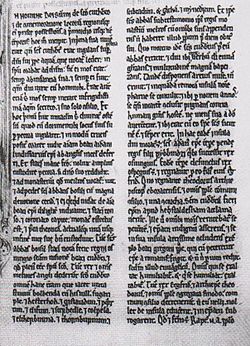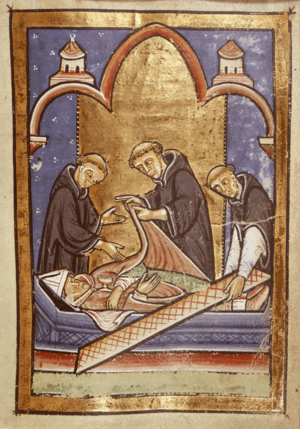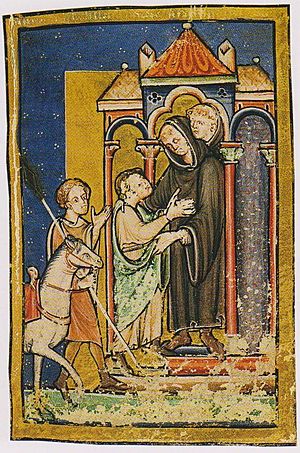Historia de Sancto Cuthberto facts for kids
Quick facts for kids Historia de Sancto Cuthberto |
|
|---|---|
| "History of St Cuthbert" | |

The opening page of the Historia de Sancto Cuthberto in the Cambridge University Library Ff. 1.27 manuscript
|
|
| Full title | Historia de Sancto Cuthberto et de Commemoratione Locorum Regionumque Eius Priscae Possessionis, a Primordio usque Nunc Temporis |
| Author(s) | anonymous |
| Patron | Bishopric of Durham |
| Language | Latin |
| Date | mid- to late-11th century |
| Provenance | Durham Cathedral |
| State of existence | three witnesses |
| Manuscript(s) | Oxford Bodleian Library, Bodley 596; Cambridge University Library, Ff. 1.27; Lincoln's Inn London Hale 114 |
| First printed edition | Roger Twysden, Historiae Anglicanae Scriptores X (1652) |
| Genre | Chronicle cartulary |
| Length | c. 6500 words |
| Subject | St Cuthbert and the property of the church of St Cuthbert |
| Period covered | 7th century to 1031 |
| Personages | St Cuthbert, Bishop Ecgred, Abbot Eadred, Cuthheard |

The Historia de Sancto Cuthberto (which means "History of St Cuthbert") is an old book finished after the year 1031. It tells the story of the church region (called a bishopric) of St Cuthbert. This bishopric moved several times, from Lindisfarne to Norham, then Chester-le-Street, and finally to Durham.
The book covers events from the life of St Cuthbert himself up to a gift made by King Cnut around 1031. It's like a mix of a history book and a record book. It lists gifts of land and property that the church received, and also properties it lost. It also shares stories of miracles that happened when people were punished for harming the church.
Today, we have three copies of this book, with the oldest one from about 1100. The very first version of the Historia is probably lost. The copies we have are believed to be from an older, missing original. This Historia was an important source for other history books written in Durham in the early 12th century.
Contents
Copies of the Historia
We know of three main copies (called manuscripts) of the Historia de Sancto Cuthberto. These are kept in libraries in Oxford, Cambridge, and London. None of these copies say who wrote the book.
The Oxford Copy
The oldest copy is found in Oxford's Bodleian Library, in a book called MS "Bodley 596". This copy is missing its first part, so it starts from chapter 8. The handwriting is an old style called "early Gothic." Some experts believe the scribe (the person who copied it) was Symeon of Durham, a famous writer from that time.
The Cambridge Copy
The copy in the Cambridge University Library, known as Ff. 1.27, is a bit newer. It's also incomplete, missing chapters 29 to 34. The handwriting suggests it was copied in the mid-12th century, or possibly a bit later.
The London Copy
The most complete copy is in London, in a book called Lincoln's Inn London Hale 114. This copy has all the chapters known from the others, plus an extra one at the end (chapter 34). It's believed to be the newest of the three copies, likely from the 15th century. This book, also known as the "Red Book of Durham," used to belong to Durham.
There might have been a fourth copy that is now lost. Notes in another old book mention parts of the Historia and say they came from a "prior's book," which was written in very old handwriting.
Modern Printings of the Historia
The Historia has been printed and published four times for modern readers.
The very first printed version was by Roger Twysden in the 17th century. This brought the book to wider attention. However, he only used the Cambridge copy, so his version was missing several chapters. Later, in the 19th century, John Hinde and Thomas Arnold published new versions. Hinde's was generally seen as better. Neither of them used the London copy, which was only discovered later in the 20th century.
In 2001, a new edition was released by Ted Johnson South. This was the first time the London copy was used, and it included the full text with notes and a translation into English. The book is usually divided into 33 chapters, a system set up by Thomas Arnold. South added the extra chapter from the London copy as chapter 34.
When Was the Historia Written?
Historians believe that none of the three surviving copies are the original book. They also think that none of the copies were made directly from each other. Instead, they all seem to be copies of an even older, lost version. This lost original might have been written in a very old style of English handwriting.
The different copies are quite similar, with only small spelling changes. One main difference is in chapter three. Some experts suggest the London copy's scribe changed the text to match other writings by Bede.
Some historians, like Edmund Craster, thought the main part of the Historia was written in the mid-10th century, soon after King Edmund visited (around 945). However, Ted Johnson South, who edited the most recent version, disagreed. He believes the entire story was likely put together in the mid- to late-11th century. He also noted that the Historia is a "composite work," meaning it was put together from different older writings.
What the Historia is About

The Historia begins with an introduction (chapter one). Chapter two tells about St Cuthbert's youth, his vision of Áedán going to heaven, and how he joined Melrose monastery under Boisil.
Early Gifts to St Cuthbert
Chapter three describes how King Oswig and his nobles gave 12 villages to Cuthbert. Boisil also gave Cuthbert Melrose and its lands. Cuthbert then became abbot of Melrose, later a hermit on Farne, and finally, bishop of Lindisfarne.
Chapter four describes the Lindisfarne region. Chapter five tells how King Ecgfrith and Archbishop Theodore gave land in York and Crayke to Cuthbert. Cuthbert then set up a monastery at Crayke and a nunnery and school at Carlisle.
Chapter six continues with stories from the northwest. It tells how Cuthbert brought a boy back to life and how King Ecgfrith gave him land called Cartmel. Chapter seven mentions King Ecgfrith's gift of Carham. Chapter eight records King Ceolwulf giving the village of Warkworth and its lands.
Changes and Challenges for the Bishopric
Chapter nine talks about Bishop Ecgred. After Cuthbert's death, Ecgred moved the bishopric to Norham, bringing the bodies of King Ceolwulf and St Cuthbert with him. He gave Norham and other villages like Jedburgh to the bishopric. He also built a church at Gainford and gave it to St Cuthbert, along with gifts of Cliffe, Wycliffe, and Billingham.
In chapter ten, things get difficult. King Osberht took back Warkworth and Tillmouth. King Ælle took Cliffe, Wycliffe, and Billingham. But the story says God and Cuthbert got revenge by sending Ubba, a leader of the Frisians, to attack Northumbria. Chapter eleven notes earlier gifts from King Ceolwulf and Bishop Esdred.
Viking Invasions and Royal Support
Chapter twelve describes how the Vikings killed Osberht and Ælle. Halfdan, the Danish king, sailed up the River Tyne, plundering the land. Cuthbert punished him with madness.
Chapter thirteen tells how Abbot Eadred helped the Danes choose Guthred, a slave, as their king in Northumbria. Guthred became king, and the Vikings promised peace over St Cuthbert's body, which Bishop Eardulf had brought.
Chapters fourteen to nineteen describe St Cuthbert's help for Alfred the Great. The Viking army split up, and Alfred had to hide. In chapter fifteen, Alfred was kind to a stranger, sharing his food. The stranger disappeared, and Alfred was rewarded with fish. Chapter sixteen reveals that St Cuthbert was the stranger. He promised to protect Alfred and his sons, saying they were chosen kings of all Britain. The book then compares Cuthbert's relationship with Alfred to St Peter and King Edwin, and Prophet Samuel and King David. It praises Alfred's fairness and records his gifts to St Cuthbert.
Chapter nineteen also mentions that Abbot Eadred bought several villages and gave them to St Cuthbert.
Moving to Chester-le-Street and New Leaders
In chapter twenty, Abbot Eadred and Bishop Eardulf traveled with St Cuthbert's body, trying to sail to Ireland but were stopped by a storm. They eventually settled in Chester-le-Street after a seven-year journey.
Chapter twenty-one describes Edward the Elder becoming king and Cuthheard becoming bishop. Bishop Cuthheard bought Sedgefield and Bedlington with their lands. Other people also gave land to Cuthbert.
Land Disputes and Miracles
Chapter twenty-two tells how Bishop Cuthheard gave land to Ælfred, who had fled from pirates. This land was later taken by Ragnall ua Ímair, a Viking leader, who defeated the English.
In chapter twenty-three, Ragnall gave land to two of his followers. One of them, Onlafbald, mocked St Cuthbert and was punished with death. Chapter twenty-four describes more land grants and a murder.
Kings and Charters
Chapter twenty-five notes the death of Edward the Elder and the start of Æthelstan's reign. In chapter twenty-six, King Æthelstan visited St Cuthbert's church before going to Scotland. He issued a charter (a formal document) giving many valuable items and coastal land to St Cuthbert. Chapter twenty-seven says Æthelstan's gifts led to his success in Scotland and a wise reign.
Chapter twenty-eight mentions Æthelstan's death and Edmund becoming king. Edmund also visited St Cuthbert's church before an expedition to Scotland.
The next four chapters (twenty-nine to thirty-two) list or summarize land grants from various people, including Styr son of Ulf, Snaculf son of Cytel, Bishop Ealdhun, and King Cnut.
Chapter thirty-three recounts a miracle: St Cuthbert caused the earth to swallow a Scottish army that had attacked Lindisfarne. The Historia ends with a warning (colophon) that anyone who takes land from St Cuthbert will be cursed.
How the Historia Influenced Later Writings
The Historia used information from older books that still exist today. For example, it used the anonymous Life of St Cuthbert and two of Bede's books: his prose Life of St Cuthbert and his Historia ecclesiastica gentis Anglorum (a history of the English church). The Historia sometimes mixed up details from these sources, but it also added unique information, like Cuthbert praying in the shape of a cross.
Much of the later information in the Historia is unique to this book. It's likely the writer used older records of land grants, which monasteries often kept in their important books. For example, the charter from King Æthelstan in chapter 27 was created by combining two older notes written in Old English and translating them into Latin.
The Historia became a very important source for other history books written in Durham in the early 12th century. These later books often copied and expanded on parts of the Historia's story, especially about King Guthred and the West Saxon kings.


